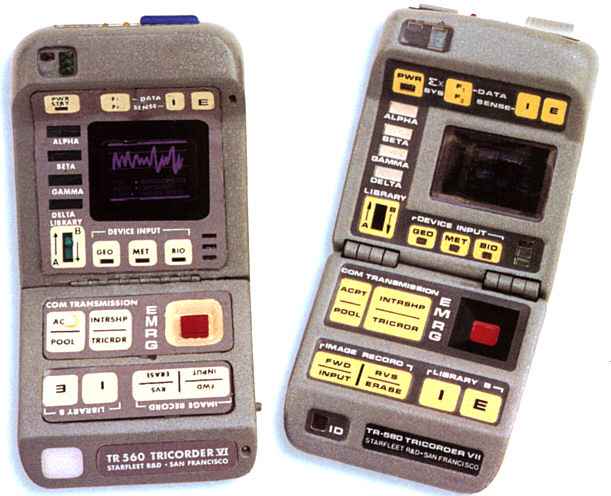| The standard tricorder is a portable sensing,
computing, and data communications device developed by
Starfleet R&D and issued to starship crew members. It
incorporates miniaturized versions of those scientific
instruments found to be most useful for both shipboard
and away mission, and its capabilities maybe aggumented
with mission-specific-peripherals. Its many functions may
be accessed by touch-sensitive controls or, if necessary,
voice command. The standard tricorder measures 15.81 by 7.62 by 2.84 centimeters and masses 298.3 grams. The casing is gamma-strengthened polyduranide. The control surfaces retain the familiar operator interface and 3.5 by 2.4 centimeter display screen. The major optronic subassemblies include the power loop, sensor assemblies, primary processors, control and Display interface, subspace transceiver assembly, and memory storage units. |
 |
| Power is provided by a rechargeable sarium-krellide
energy cell rated for thirty-six hours of continuous use
with all subsystems active. This value will increase with
fewer active subsystems. The typical power level is 16.4
watts. The sensor assemblies incorporate a total of 315 mechanical, EM, and subspace devices mounted about the internal frame and embedded in the casing. One hundred eighty-nine are clustered in the forward end for directional readings, with a field-of-view (FOV) lower limit of 52.3 arc-seconds. The other 126 omnidirectional devices make measurements of the surrounding space. The TR-590 polled main computing segments (PMCS), the primary data processors, are divided among the five inner casing surfaces and are rated at 275 giga-floating point(GFP) calculations per second. The data-storage sections include eight wafers of densified chromopolymer isolinear crystal for a total capacity of 9.12 kiloquads. The control and display interface (CDI) routes commands from the panel buttons and display screen to the PMCS for execution of tricorder functions. The opaque control surfaces are fabricated from a thin-film copper dilefinate infused with metallic dyes to fix the graphical content. The display screen incorporates a standard nanopixal matrix similar to that used in PADDs and consoles. Communications with other data units is performed by the STA, with a range limited to 40,000 km, similar to the combadge. |
 |